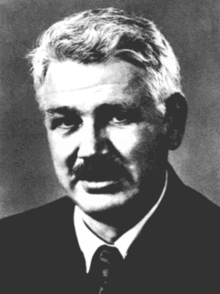
Back كارلتون ستيفنز كون Arabic كارلتون ستيفنز كون ARZ کارلتون استیونز کون AZB Carleton S. Coon Welsh Carleton S. Coon German Carleton S. Coon Spanish کارلتون استیونز کون Persian Carleton Coon Finnish Carleton Coon French Carleton Stevens Coon Italian
Carleton S. Coon | |
|---|---|
 | |
| Born | June 23, 1904 |
| Died | June 3, 1981 (aged 76) |
| Board member of | President of the American Association of Physical Anthropologists |
| Spouses |
|
| Children | |
| Parents |
|
| Awards |
|
| Academic background | |
| Education |
|
| Thesis | A Study of the Fundamental Racial and Cultural Characteristics of the Berbers of North Africa as Exemplified by the Riffians (1928) |
| Doctoral advisor | Earnest Hooton |
| Academic work | |
| Discipline | Anthropology |
| Sub-discipline | |
| Institutions | |
| Notable students | |
| Notable works |
|
Carleton Stevens Coon (June 23, 1904 – June 3, 1981) was an American anthropologist and professor at the University of Pennsylvania. He is best known for his scientific racist theories concerning the parallel evolution of human races, which were widely disputed in his lifetime[1] and are considered pseudoscientific by modern science.[2][3][4][5][6]
Born in Wakefield, Massachusetts, Coon became interested in anthropology after attending Earnest Hooton's lectures at Harvard University. He obtained his PhD in 1928 based on an ethnographic study of the Rif Berbers of Morocco. Returning to Harvard as a lecturer, he conducted further fieldwork in the Balkans, North Africa, and the Middle East. In 1948 he was appointed a professor of anthropology at the University of Pennsylvania and remained there until his retirement in 1963, also serving as the Curator of Ethnology at the Penn Museum. During the Second World War, he was an agent for the Office of Strategic Services (OSS), where he used his anthropological fieldwork as a cover for an arms-smuggling operation in German-occupied Morocco. He was awarded the Legion of Merit and after the war he retained ties to the military and the OSS' successor the Central Intelligence Agency. He wrote about his wartime experiences in his book, A North Africa Story: The Anthropologist as OSS Agent (1980).
Coon's early work in physical anthropology, such as The Races of Europe (1939), was typical of its time. He described the different racial 'types' supposedly present in human populations, but rejected a specific definition of 'race' and made no attempt to explain how these types arose. This changed after 1950, as Coon attempted to defend an essentialist concept of race against the new physical anthropology of contemporaries such as Sherwood Washburn and Ashley Montagu, who argued that the emerging understanding of human genetics negated race as a scientific category. In The Origins of Races (1962), Coon set forth his theory that there were five distinct subspecies of Homo sapiens that evolved in parallel in different parts of the world, and that some had evolved further than others. The book widely castigated upon its publication and marked a decisive break between Coon and the scientific mainstream. He resigned the American Association of Physical Anthropologists in 1961, after it voted to condemn a white supremacist book written by Coon's cousin Carleton Putnam. Though Coon continued defend his theories until his death and rejected the accusations that he was a racist, they were quickly excluded from the scientific consensus as "outmoded [...], typological and racist".[2]
Aside from physical anthropology, Coon conducted a series of archaeological excavations of Stone Age cave sites in Iran, Afghanistan and Syria. These included Bisitun Cave, where he discovered traces of the Neanderthals, and Hotu cave, which he claimed showed evidence of early agriculture, though subsequent excavations proved this false. He was also a lifelong proponent of the existence of cryptid 'Wild Men' such as the Sasquatch and Yeti, which he believed were relict populations of human-like apes that, when found, would support his theory of the separate origins of human races. He was involved in planning 'Yeti-hunting' expeditions to Nepal and Tibet, though it has also been speculated that these were cover for espionage.
Coon was married twice, first to Mary Goodale and then to Lisa Dougherty Geddes. He had two sons, including Carleton S. Coon Jr., a diplomat who served as the American Ambassador to Nepal. He died in Gloucester, Massachusetts in 1981.
- ^ Jackson 2001.
- ^ a b Sachs Collopy, Peter (2015). "Race Relationships: Collegiality and Demarcation in Physical Anthropology". Journal of the History of the Behavioral Sciences. 51 (3): 237–260. doi:10.1002/jhbs.21728. PMID 25950769.
- ^ Spickard 2016, p. 157, "For more than four decades beginning in the late 1930s, the Harvard anthropologist Carleton Coon wrote a series of big books for an ever shrinking audience in which he pushed a pseudoscientific racial angle of analysis."
- ^ Selcer 2012, p. S180, "Most disturbingly for liberal anthropologists, the new generation of racist "pseudoscience" threatened to return to mainstream respectability in 1962 with the publication of Carleton Coon's The Origin of Races (Coon 1962)."
- ^ Loewen 2005, p. 462, "Carleton Coon, whose The Origin of Races [...] claimed that Homo sapiens evolved five different times, blacks last. Its poor reception by anthropologists, followed by evidence from archaeology and paleontology that mankind evolved once, and in Africa, finally put an end to such pseudoscience."
- ^ Regal 2011, pp. 93–94, "Carleton Coon fully embraced typology as a way to determine the basis of racial and ethnic difference .... Unfortunately for him, American anthropology increasingly equated typology with pseudoscience."
© MMXXIII Rich X Search. We shall prevail. All rights reserved. Rich X Search